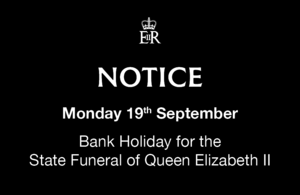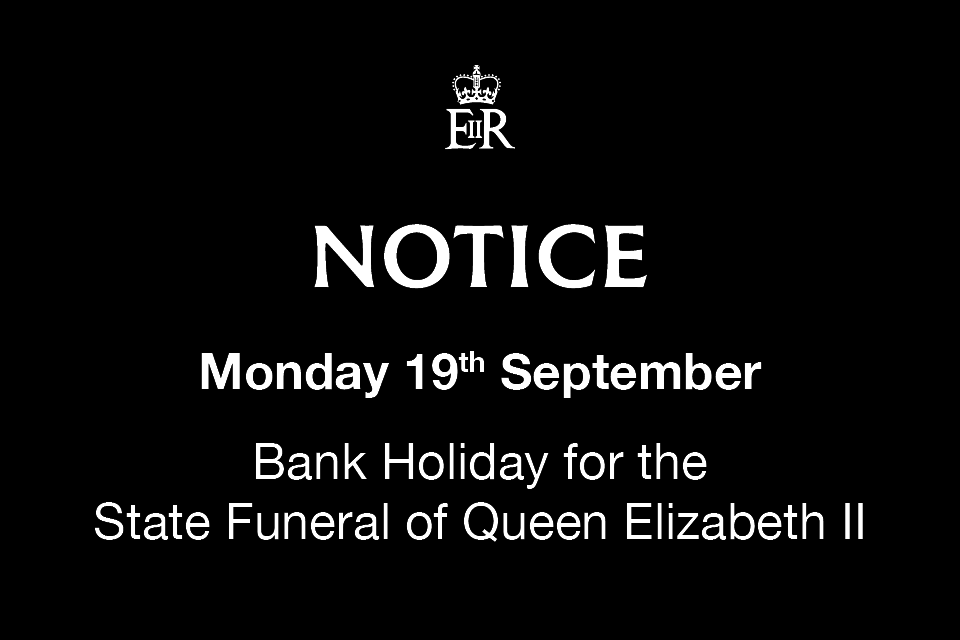Monday 19th September 2022, the date of Her late Majesty Queen Elizabeth II’s State Funeral, will be a UK Bank Holiday. A statement released via the UK Government website says “Monday 19 September, the date of Her Majesty Queen Elizabeth II’s State Funeral, will be a national bank holiday”. Business owners, leaders and managers have only a few days to decide how to manage the additional bank holiday.
“This will allow individuals, businesses and other organisations to pay their respects to Her Majesty and commemorate Her reign, while marking the final day of the period of national mourning.” “This bank holiday will operate in the same way as other bank holidays, and there is no statutory entitlement to time off. Employers may include bank holidays as part of a worker’s leave entitlement."
This date marks the final day of the period of national mourning. UK Government advice is clear, to a point. The way you manage the additional bank holiday is largely dependent on the wording of your contracts of employment, custom and practice in your business, and given the unique circumstances you’ll also need to be sensitive to the needs of your team. The broad advice from the UK Government is that “this is a matter for discussion between individuals and their employer”. If nothing else, we’d advise you to take a sensible, pragmatic approach and ask your team what they want to do.
We’ve done our best to pull together a practical set of FAQs with sensible suggestions on how to manage the additional bank holiday. Please get in touch if you need specific advice for your business or organisation. A note about our FAQs and examples: please do not interpret this article as formal guidance or legal advice. Our FAQs and examples are here to guide your decision-making process but we’d always suggest you consider in the broader context of your customer needs, contractual terms and your workplace culture.
No, if you would normally be open on Monday 19th September 2022 there is nothing in law to prevent you from opening as normal. It’s worth bearing in mind that over the weekend we’ve all seen pictures and videos of the huge national outpouring of grief and celebration of Her late Majesty’s life. It likely that you have customer, suppliers, key stakeholders and prospects who will want to celebrate the life of Queen Elizabeth II. By the same token there will be others who will not want to commemorate her reign and will want to escape the news coverage and media reporting. This isn’t a royalist vs. republican ‘thing’; you need to do what’s right for your organisation. You’ll also need to weigh-up the benefits and practicalities of staying open vs. closing, including whether you have enough team members available (which leads us nicely onto our next question…).
Yes, we understand that all public-sector schools will be closed on 19th September 2022. Colleges and Universities are also likely to be closed (TBC). We also expect all UK Government Departments and Local Authority offices to be closed, although critical services such as the National Health Service and other 24/7 services will remain open. Please check with your local service providers for specific opening times. Naturally, this means that families, parents and grandparents of school-age children will either need to find childcare within the next few days, or will need to talk to you about whether they can have the day off work. We think it’s better to manage time-off as sensibly as possible, taking all the learnings from the agility and responsiveness shown by teams during the COVID-19 pandemic. If you can manage time-off without resorting to formal policies and procedures, particularly for families and working parents and grandparents, so much the better.
In a word, no. There is no statutory entitlement to time off for bank holidays. You don’t ‘have to’ give colleagues the day off but you might want to consider requests for annual leave if you’re not closing on 19th September 2022. If you are closing and would normally be open, most (if not all) employees should be paid as normal if they’re available for work.
Interestingly, the UK Government has said: “The government cannot interfere in existing contractual arrangements between employers and workers.” “However, we would expect that many workers will be able to take the day off on the bank holiday.” “We also expect employers to respond sensitively to requests from workers who wish to take the day of the funeral off work.”
Example 1 – your contract of employment states ‘employees are entitled to 20 days annual leave (statutory minimum) plus public/bank holidays’. Yes, your employees are entitled to an extra day’s holiday. Why? Because 19th September 2022 is public/bank holiday and the example contract wording doesn’t state (or limit) the number of public/bank holidays. Don’t forget: part time workers are entitled to a pro-rata amount based on their working hours/pattern.
Example 2 – your contract of employment states ‘employees are entitled to 28 days annual leave including public/bank holidays’. A probable interpretation of the wording would suggest ‘yes’, they’re entitled to an additional holiday. Why? The statutory minimum of annual leave is 20 days and there will be 9 public holidays in 2022 (29 days) Huh? The wording of the contract says ‘including’ public/bank holidays without specifying the exact number, but since offering <20 days annual leave is not legal, an additional day’s entitlement is implied. Don’t forget: part time workers are entitled to a pro-rata amount based on their working hours/pattern.
Example 3 – your contract of employment states employees are entitled to >28 days annual leave including public/bank holidays, for example ‘35 days annual leave including public/bank holidays’. A strict interpretation of the wording would suggest ‘no’, they’re not entitled to any additional holiday. Why? You already offer greater than the statutory minimum of annual leave and public holidays, and the wording says ‘including’ without specifying the exact number. Given the unique circumstances you may decide to grant the additional day either on-the-day or as an addition to your employees’ total time-off allowance for the year.
This list isn’t intended to cover every situation. Naturally there may be other examples of working patterns and contractual entitlements. Always check your contracts before making any decisions and if you’re not sure, talk to your HR Business Partner or give us a call.
What is the UK Government advising employers to do? There are so many different and unique contractual arrangements between employers and employees, it’s impossible to come-up with a list of instructions that will cover all eventualities. The UK Government has put out a press release which covers the basics. You can read the full press release on the UK Government website.
Four practical things to do this week Make a decision, ideally by mid-week to give you plenty of time to communicate what’s going on. For your team, the earlier you can decide the better, especially if they’re going to need to make arrangements for childcare. This is important for everyone, including your customers. If you are closing, make sure you update your Google Maps listing and other directories where you publicise your opening hours, otherwise your team might come back to complaints from people trying to reach you. Get HR and/or legal advice (if you need to). If your contractual entitlements or working arrangements are complex, don’t be afraid to get some help from your HR and legal advisors. It’s best to be safe. Update your HR / Annual Leave system with the additional bank holiday. If you use a service provider they’ll probably have a help page on their knowledge base to help you get this done. Just bear in mind they can’t make the decision on how to handle the additional day, so if you decide to give everyone an additional day off, you’ll probably need to do a bulk upload/change of annual leave entitlement too. Remind your employees about your Employee Assistance Programme. Over the weekend we’ve seen how many people have come out to share their grief and celebrate the life of Her late Majesty Queen Elizabeth II. Some people in your team may have been deeply affected by the death of The Queen, they may need to access the wellbeing services via your Employee Assistance Programme (EAP). Similarly there may be people in your team who do not support the monarchy or the Royal Family and have been triggered by the events of the past few days; they too may benefit from the services of your EAP.
Don’t know where to start? There’s only a few days to make arrangements and communicate with your team and your customers. If you’re struggling to wade through contractual entitlements and the practicalities of the additional bank holiday, feel free to give me a call for support and advice.

Here’s the answers to the FAQs we’ve been asked (so far)…
Do I have to close my business on 19th September 2022?
There is no legal requirement to close your business on 19th September 2022
Are schools, colleges and other government services going to be closed on 19th September 2022?
Schools will be closed on 19th September 2022
Does the bank holiday mean that I have to give employees the day off work?
There is no statutory entitlement to time-off on a bank holiday
Check your contractual entitlement wording before making any decisions
There is no 'one size fits all' set of instructions for employers
Tag: Hybrid Working
How to Lead Hybrid Teams
Shake it all about! We all know traditional working practices have changed. People have been flipping between being in and out of the office for over 2 years now. Something which has undoubtedly shaken many companies.
Lots of office workers have now been instructed to return for at least some of the week. But the situation that greets them varies hugely between organisations, internal teams and even pay grades.

How does it feel if your CEO has said you have to be in the office everyday, but you’ve not seen them up close and personal for weeks?
Or how about if some teams in the business are in, but others are entirely home-based?
The aftermath of the pandemic has left a huge swathe of organisations with fragile, fractured or ‘not quite figured out yet’ working environments. Some organisations moved quickly to new working policies whereas others have muddled along without formalising new ways of working.
C-suite executives expect 87% of work to be done via some form of hybrid working
According to research by McKinsey, most organisations don’t yet have a detailed vision in place for hybrid working, with as few as 3 out of 10 organisations having both prepared for and communicated their vision for the post-pandemic world. Despite this, executives expect most work to be done via some form of hybrid work in future. Perhaps many of us are still in ‘reaction mode’ and the case for hybrid working is still unclear?

Why could a hybrid working model be good for my business?
If you’re considering it, it’s probably because you’re already doing it in some way. Hybrid working became a necessity in the pandemic.
Some organisations only did it because they had to, and for some companies, being at work in person will always be the best model for them.
Hybrid working is no longer a ‘nice to have’, it’s a ‘must have’ for most workers
Benefits of Working at Home
-
Focused periods of concentration on tasks that are best done uninterpreted.
-
A place to do virtual calls.
-
Good for those who need adjustments to their working environment, such as people with a disability.
-
More useable time in the day for those who have a lengthy commute.
-
A better work/life balance.
Benefits of Being in The Workplace*
Informal learning of technical knowledge… being in earshot of colleagues.
Learning good leadership skills by listening to and ‘soaking up’ the actions of positive role models.
More chance to naturally include less confident colleagues, in meetings that are in-person.
More opportunities for new starters to absorb company culture.
*Not of the ‘benefits’ of working in the workplace are effective if leaders and relevant colleagues are not there… AT THE SAME TIME!
Absorbing and contributing to company culture is virtually impossible at home

How do I lead a fully hybrid team?
Hybrid working is not new. Tech companies like Google have been doing it across teams successfully for many years.
The reason they and others adopted it in the first place was because it was better for productivity.
For hybrid working to work, leaders need to be clear and visible and employees need to understand how their work fits into big picture company objectives.
Agree the ground rules for hybrid working, including what leaders need to do
Five practical steps to successful hybrid working
There are some specific steps that every leader can take to make hybrid working work for you, your team and most importantly, your customers. One word of warning before you start…don’t be the CEO that says everyone has to work in a certain way, except you. That’s a sure-fire way to make sure hybrid working doesn’t work.
Step 1 – Make an Agreement (Formal or Informal)
If people have become used to the flexibility of 100% home working they need time to put a new routine in place.
Remember, people will be factoring in the cost of commuting, cost of living and childcare responsibilities.
You may be perfectly entitled to have them back in the office but do it with compassion.
Top Tip: an informal or formal agreement can help get people back into the office, particularly if different parts of your business need different levels of on-site and remote working.
Step 2 – Lead by Example
You may have always worked from home as a leader, but for hybrid working to be successful, days in the office have to be really meaningful.
You need to model this way of working to make sure that engagement with company culture and productivity stays high.
Not sure your company culture is strong enough? Here are 10 proactive things you can do as a leader to improve your culture.
Step 3 – Make Office Dates Matter
Understand which tasks work better at home and which benefit from face-to-face communication and plan around this.
There is no point in scheduling lots of virtual calls on a day when everyone’s in the office. It’s pointless. (Ever travelled to work, done a day of Teams or Zoom calls from the office, then travelled home when you could have been anywhere? Ergh.)
Also try to schedule company-wide office dates so that people are able to ‘drop in’ on useful colleagues.
Step 4 – Plan Unstructured Collaboration Time
Scheduling unstructured collaboration time will invigorate your team, encourage creative thinking and help people feel positive about coming into work.
A Deloitte survey of over 3,500 workers showed that people are up to 20% more satisfied with their workplace culture when they have access to collaboration tools that enable them to work in teams, and 34% happier with their workplace when collaboration and innovation are encouraged.
We also know that productivity, revenue, and profitability are all positively impacted by engagement at work – collaboration with colleagues is just one way to keep your team engaged.
Step 5 – More Office Time For New Starters & Their Managers
Your organisation is a complex web of different traits, habits, actions … ways of communicating.
All of these are compromised if newbies aren’t properly integrated into the organisation.
Plan extra time in the office for people joining your organisation and their managers.
Top Tip: set an expectation that managers are on-site with new colleagues for their induction, you can share the responsibility amongst a pool of managers so new starters kick-start their internal networking.
Ringfence your time at the office for collaboration and engaging with your team

Why can’t I get my team to come back to the office?
Lots of people like working from home but it’s not without challenges, subsequently a sensible hybrid model is a pretty logical way of working for most people.
So, if you’re really struggling to get people to come back, it’s likely that your office was not a welcoming, inclusive and flexible environment in the first place!
If you’re a leader that would like a conversation about how to create and manage a hybrid working model, get in touch. We’ll show you how to enhance every professional relationship across your entire business.
A welcoming, inclusive and flexible workspace is essential for hybrid working
Don’t know where to start?
I know that making changes to your workplace and culture can be daunting – most people don’t know where to start.
I love working with Exec Teams to improve performance and unleash the potential of their organisations. Who knows what you might achieve?
Give me a call if you want to explore the options for hybrid working in your team.
Image credits
Images sourced from Canva Pro and are photographers are not individually credited. If you see one of your photos above,please let us know so we can credit you here. Photo of Andrew Knight by Nick Morrish from Nick Morrish Photography
References
Digital collaboration. Delivering innovation, productivity and happiness. Deloitte (2013)
What executives are saying about the future of hybrid work. McKinsey & Company (2021)


